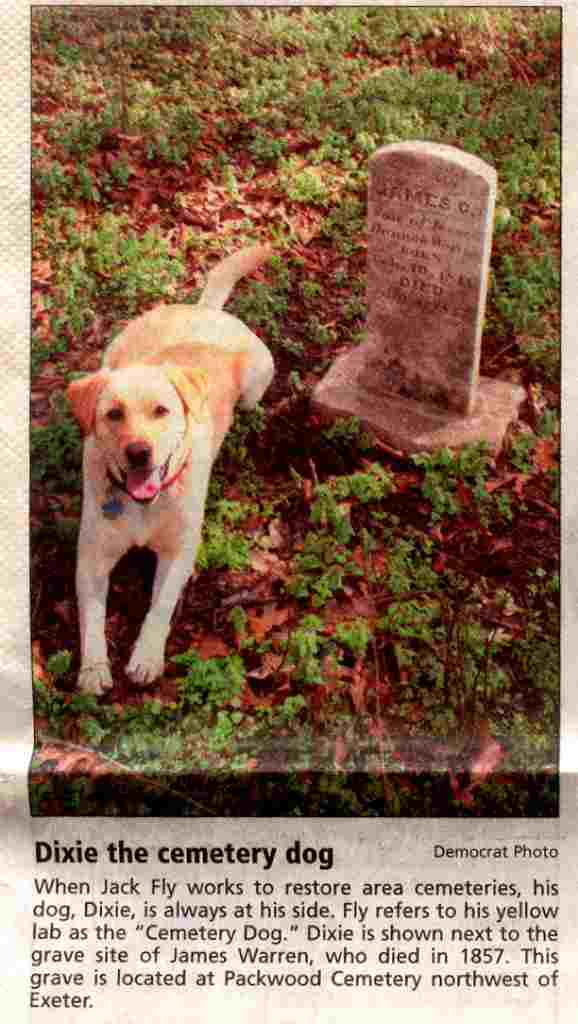Repair and Restoration of Packwood

|
Jack said that Lisa really did a good job writing the story. She only had a couple of facts wrong like Lee Chilcutt dying instead of Dr. Harris and she had Corsicana cemetery located northwest of Purdy instead of southwest. Jack Fly Cassville Democrat - April 12, 2007 Cemetery restoration effort underway By Lisa Schlichtman Tucked away beside a dirt road on a piece of pasture northwest of Exeter lies a Civil War-era cemetery that offers interesting evidence of Barry County's past. This cemetery is not surrounded by a fancy wrought-iron fence but instead is bordered by twisted strands of barbed wire. Once covered with vines and thorny overgrowth, weathered tombstones and crumbling grave markers are now exposed. Names and dates of death chiseled into stone have been worn down by wind and rain and are sometimes barely readable. Some of the grave sites are unmarked while others are tagged by badly broken or buried stones. This long neglected cemetery is now getting the attention it deserves as dedicated volunteers with the newly formed Barry County Cemetery Restoration and Preservation Committee work to save the site from further decay. Last week, Jack Fly, one of the Committee's founders, and Ted Roller, an avid local historian and committee member, were busy clearing more brush from the site of the old Packwood Cemetery. The land where the cemetery lies was originally purchased from the United States government by John Packwood in the 1850s under a U.S. land patent. The property is now owned by the Senters family. Fly and Roller spoke as if they had discovered buried treasure as they explained the history of some of the gravesites they had uncovered. In particular, Fly described the thrill he felt when he found a stone inscribed with the name of Elias Price, lying in two pieces in a back portion of the cemetery. Fly said the discovery supported a historical account he had read describing the grizzly murders of four Southern sympathizers by the Union Home Guard. According to a report written by Capt. Joseph G. Peevy with Company B of the Hunter's Regiment of the Missouri Infantry and dated April 17, 1863, Robert H. Christian, a first lieutenant of the Missouri Militia, committed a vile act that Peevy described as "one of the most diabolical, cold-blooded murders that I heard of during my trip." Peevy reported that Lt. Christian shot and killed four "old" citizens living west of Cassville. Their names were Elias Price, Asa Chilcutt, Thomas Dilworth and Lee Chilcutt. Another account of these killings, found by Fly, described the crime in more vivid detail. Thomas Sallee, of Exeter, was interviewed in 1931 and said all four men were shot in the right eye and their brains were taken out, put in their hats and set beside their bodies, which were all "buried in one large grave in the old Packwood Cemetery." The discovery of a grave stone bearing Price's name confirmed those reports and helped uncover more of Barry County's Civil War past. "Cemeteries are many things to many people," said Fly. "To me, they're not only the resting places of our county's pioneer families but a large history book." It was Fly's passion for restoring old cemeteries that sparked the beginning of the Barry County cemetery restoration project. As a child growing up in Monett, Fly remembers taking Sunday drives to the Corsicana Cemetery with his family. Upon his move back to the area in February of 2005, one of Fly's first stops was to the family cemetery located northwest of Purdy. "I found it in shambles," said Fly. "The cemetery was mowed but stones were broken and knocked over. "After repairing nine family stones I decided it just wasn't right to leave the other 40 or so broken," said Fly. "I decided to repair and reset all the stone, and after repairing about 35 stones, my personal funds for the project were running low." At that point, Fly said he made a presentation about his project to the Barry County Genealogical and Historical Society and got a very positive response. "They were impressed with the efforts and decided to provide funding for the materials needed to continue the work at Corsicana," Fly said. An official Cemetery Restoration and Preservation Committee was appointed in October of 2005 with Fly, Roller and Jay Trace making up the committee membership. The goal of the cemetery restoration committee is to locate, record, photograph, and where feasible, restore all the abandoned cemeteries and grave sites in Barry County. So far, the group has focused its efforts on the Corsicana, Ferguson and Packwood cemeteries. "A number of single or small family grave sites have been cleaned up and stones repaired and reset at these cemeteries," said Fly. The work required at each cemetery varies, ranging from minimal clean-up to combatting overwhelming neglect. Once brush is cleared, volunteers conduct a thorough search of the area, looking for stones that are standing, knocked over or buried. A record is made of all the stones found. These stones are also photographed and their location recorded. If at all possible, broken stones are repaired and reset. Right now, Fly has 15 pieces of a grave stone out of the Purdy Cemetery lying on his kitchen table, waiting to be reset in a concrete form that matches the original stone's shape. In order to continue the goals of the Barry County Cemetery Restoration and Preservation Committee, the group needs donations of time and money. The Committee is also asking for information pertaining to the location of other abandoned cemeteries or grave sites that need to be restored. The group is willing to work at any location as long as it is fenced in some way to protect from future damage. "There's no sense in restoring the cemetery and letting cows run over it again," said Fly. Submitted in 1999 by Jack Fly |

